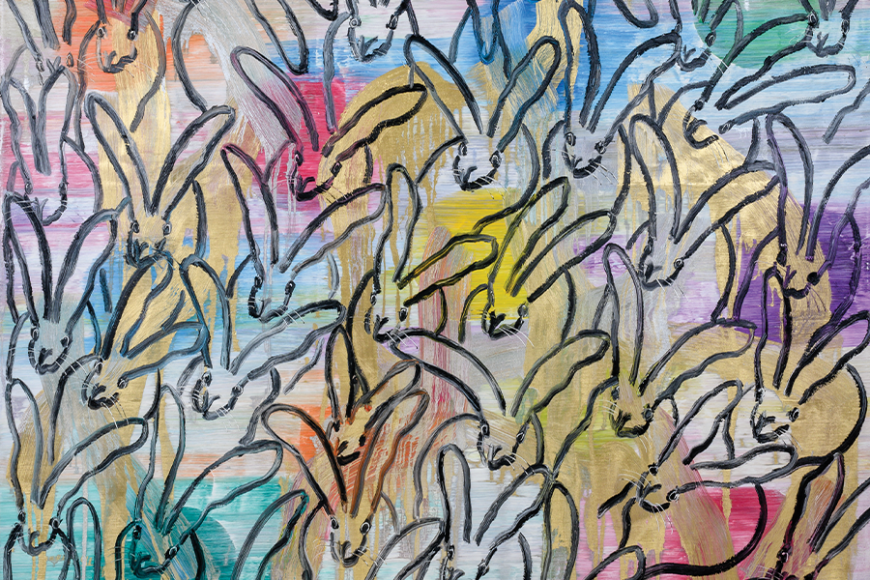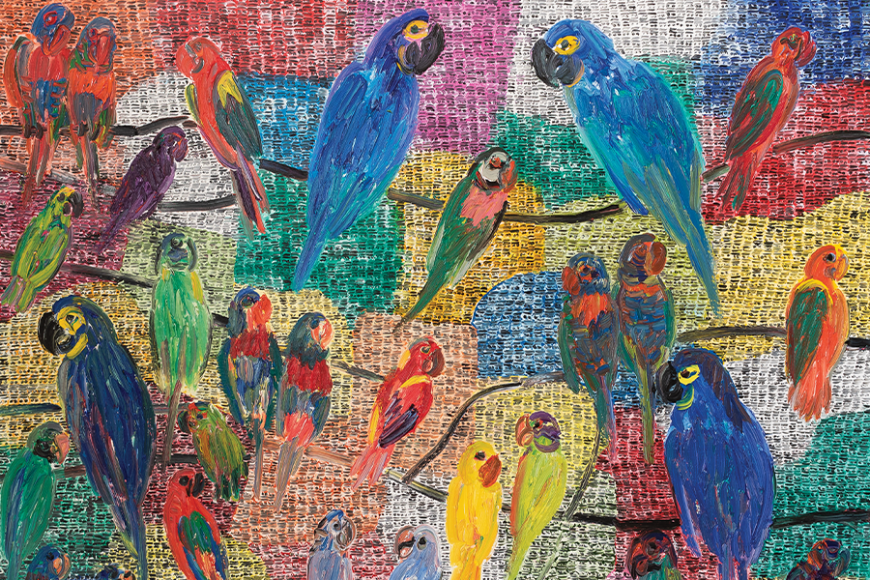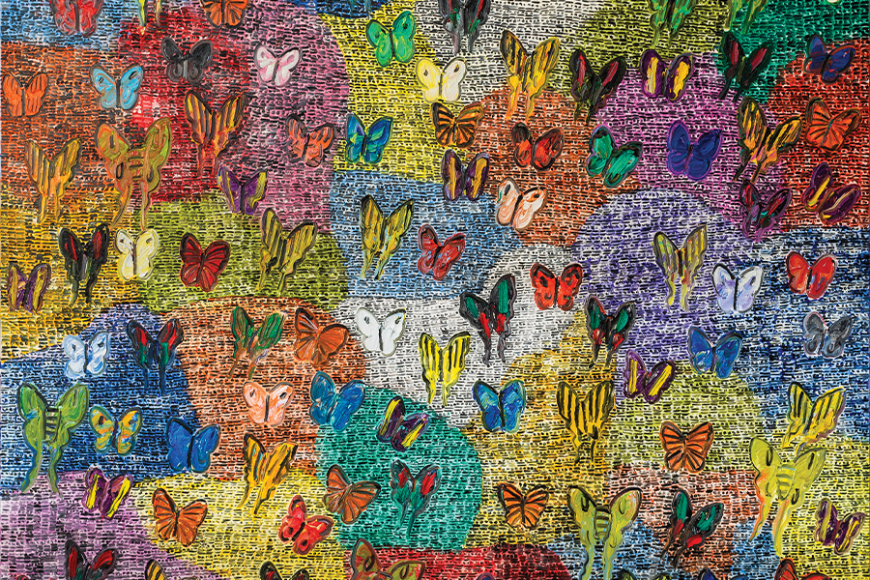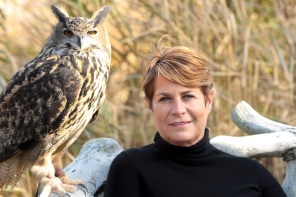With Easter just around the corner, April, often referred to as “the cruelest month” — thank you, T.S. Eliot — may possibly be one of the happiest for New York-based, bunny-rabbit obsessed artist, Hunt Slonem.
Along with bunnies, Slonem — ample-framed and broad-faced, a cheerful cross between late actors Philip Seymour Hoffman and Bob Hope — is known, of course, for his series of butterflies, and tropical birds.
Born in Kittery, Maine, in 1951, Slonem had a peripatetic childhood in Connecticut, California and Hawaii, as his navy officer father moved the family around the country. A year spent in Nicaragua as an exchange student further influenced him, giving him a lifelong love of what he calls “exotica.”
Arriving in New York in the 1970s, Slonem worked with Andy Warhol, and the influence is clear, not only in the production line-type repetition of the subject — actually a religious reference for Slonem, akin to prayer — but also in the way his New York studio resembles a factory, as indeed Warhol’s did. A “typical” bunny — face and a pair of ears, black on a luminous green or vivid pomegranate red background — goes for around $5,000, although a new auction record was set last year for a work by Slonem. His 1986 oil on canvas, “Healer, Dr. Gregorio Hernandez,” which was featured on the cover of Tama Janowitz’s 1987 novel, “American Dad,” sold for $80,000 at auction in New Orleans in May 2019.
Most closely associated with Neo- or Abstract Expressionism, he calls his bunny paintings his “warm-up paintings.” He is also Marie Kondo’s nightmare. He needs clutter around him, collecting houses (two in New York, two plantations in Louisiana), good porcelain, top hats, neo-gothic chairs and — wouldn’t you know — marble busts of Marie-Antoinette. Even the term “Renaissance man” can’t quite contain him, this multitalented artist who has also thrown himself into sculpture, architectural restoration and car design, in addition to his prodigious painting from nature.
As for where Slonem has exhibited, the names read like an atlas — from Kansas City to Kazakhstan, from Anguilla in the British West Indies to Amsterdam. (In WAG country, his work was most recently seen at Madelyn Jordon Fine Arts in Scarsdale.) His paintings are currently in the permanent collections of more than 250 museums across the globe. This year, COVID-19 permitting, will see Slonem exhibiting in eight shows worldwide, from La Jolla, California, to Latvia. His industry and energy are frankly staggering.
There is humor, too, of course, in the art. And pure joy. The delicious pastel colors of Raoul Dufy, the oddly satisfying repetition of Warhol, the childlike sincerity of Henri Matisse, the utter sophistication of Leonardo da Vinci — all these elements can come into play in a Slonem canvas, where the almost fanatical retelling of the subject achieves a kind of religious potency. Yes, his paintings may be deceptively “simple,” but his art is never naïve.
The concept of “simplicity” in art is, at least to my mind, fascinating. Slonem is the archetypal artist — think Fernand Léger, too, say, and Jackson Pollock — of whom you say, “that’s so easy, a child could do it,” but when you put paint to paper, all you end up with is a sorry mess. Writing this piece, I actually tried to draw butterflies (which Slonem paints by the score) on a thick piece of cartridge paper, to prove to myself how “easy” it would be, and before I had even drawn half a wing I was — forgive the pun — beaten.
Interesting, too, because for all Slonem’s work that is lifelike and figurative, I always have the feeling that those paintings from nature are ephemeral, fleeting, will-o-the-wisp. And that, despite their sheer numbers, you will never trap the butterflies, never catch the bunnies, no matter how many Slonem paints. They are, in that sense, illusory — the bunny in the top hat (of which he is so fond of collecting.)
It is also true that, despite first appearances, no two pictures are ever “the same.” It takes the artist’s eye to appreciate the infinite variety and latent beauty in that sharp, well-defined V of a rabbit’s ears. The same is true of the parrots, similar, of course, but no two the same. They are literally Slonem’s studio models, around 60 of them, caged and uncaged, whom he constantly observes, no swoop, no twitch, no flutter, not captured in Slonem’s art.
He is also a shameless and dogged (or should that be bunnied?) merchandiser. Witty, too. The “Hop Up” shop on his website features bunny scarves, bunny pillows, bunny totes; also, bunny bowls, bunny napkins, bunny placemats and — naturally — bunny T-shirts. A lot of the bunny plates are currently sold out, but you’ll be notified when the product becomes available.
Color is everything for Slonem, both professionally and privately. Electric blue, acid green or Schiaparelli “shocking” pink are favorite jacket colors when it comes to a night on the town (of which Slonem had more than his fair share of in the heady Studio 54 days of the 1970s), while his taste in furniture — heavy gilt 18th century French fauteuils (armchairs), for instance, for which he has a fondness — is either an elaborate tease or else not-so-borderline kitsch.
Now in his 70th year, Slonem’s demeanor suggests the sharpest mind tempered with a touch of world-weariness. One thing’s for certain: He shows no sign of slowing down. In fact, he seems to be working harder than ever. So, if you’ve had the puppy for Christmas and are looking to broaden your pet collection, now may be the time to acquire a bunny — a Slonem bunny, naturally — for Easter.
For more, visit huntslonem.com.







